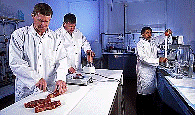United States Department of Agriculture: Agricultural Research Service, Lincoln, Nebraska

Roman L. Hruska U.S. Meat Animal Research Center: Reports
Date of this Version
7-1979
Document Type
Article
Citation
Agricultural Reviews and Manuals Science and Education Administration, U.S. Department of Agriculture (July 1979).
Abstract
The cattle Germ Plasm Evaluation Program has been conducted in three cycles. Cycle I involved breeding Hereford, Angus, Jersey, South Devon, Limousin, Simmental and Charolais bulls by artificial insemination (AI) to Hereford and Angus cows to produce three calf crops (Cycle I, Phase 2) in the spring of 1970, 1971 and 1972.
Cycle II, initiated with the 1972 breeding season, involved the Hereford and Angus cows used in the first cycle. These cows were bred by AI to Hereford, Angus, Red Poll, Brown Swiss, Gelbvieh, Maine Anjou and Chianina sires to produce two calf crops (Cycle II, Phase 2) in the spring of 1973 and 1974. In addition, in Cycle II, Phase 2, Red Poll and Brown Swiss cows were added to the program and mated to Hereford, Angus, Red Poll and Brown Swiss sires to provide for a four-breed diallel crossbreeding experiment.
Cycle III was initiated during the 1974 breeding season. In Cycle III, the Hereford and Angus cows used to initiate Cycles I and II were mated by AI to Hereford, Angus, Pinzgauer, Tarentaise, Brahman, and Sahiwal sires to produce two calf crops (Cycle III, Phase 2) in the spring of 1975 and 1976.
Fifteen of the Hereford and 16 of the Angus sires used in Cycle I were also used in Cycle II and Cycle III to insure a stable control population of Hereford and Angus reciprocal crosses that are used as a basis for comparison between different cycles and phases of the program. Within each cycle of sire breeds, foundation cows (Hereford and Angus, in Cycles I, II and III, plus Red Poll and Brown Swiss in Cycle II) are referred to as Phase 1. Their calves are called Phase 2, and the calves from Phase 2 cows are designated Phase 3. Specific mating plans for each cycle and phase of the program are provided in the appendix.

